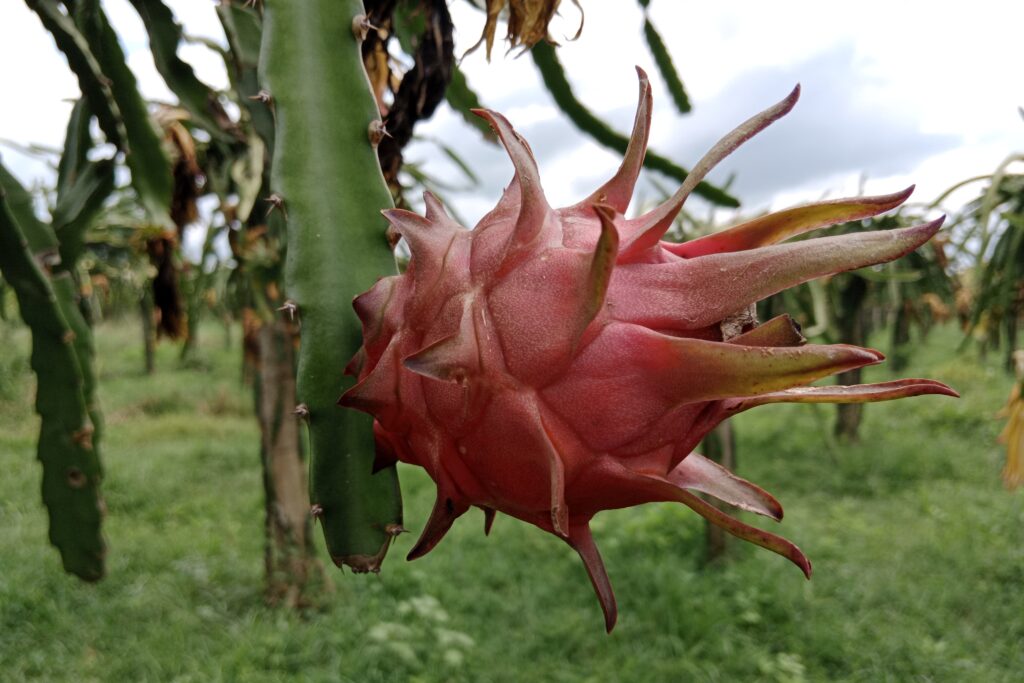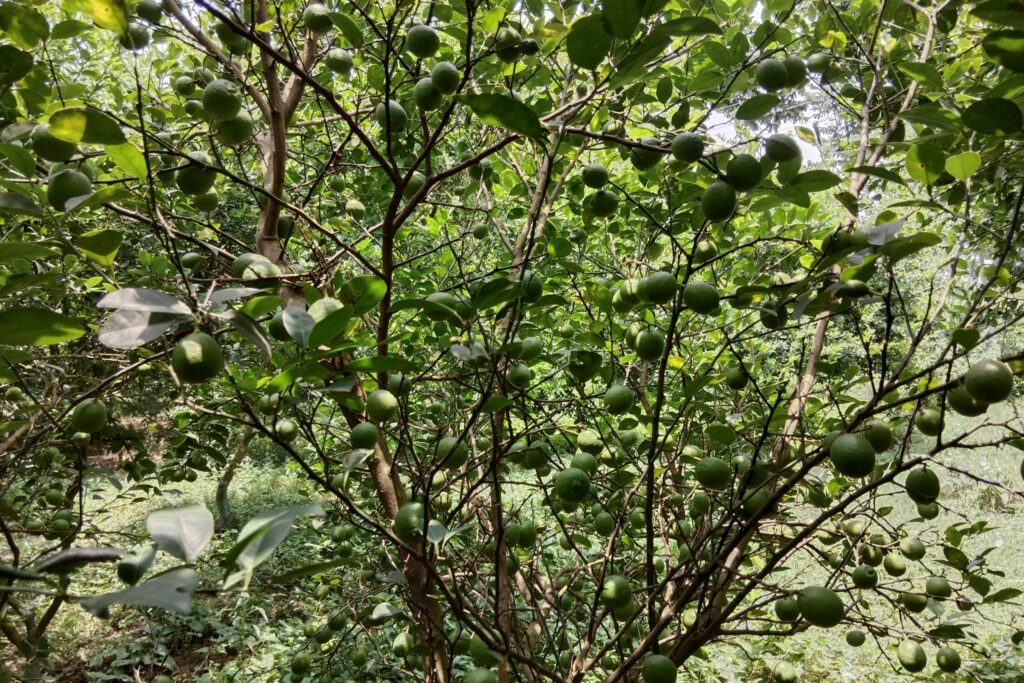Jute Farming
A detailed assessment of jute farming profit per acre reveals highly favorable economics: with a total investment of NRs. 23,000 covering land preparation, inputs, labor, and post-harvest processing, and gross income reaching NRs. 100,000 from fiber yield (1,000 kg/acre at NRs. 100/kg), net profit stands at NRs. 77,000 per acre – translating to a robust 77% profit margin and exceptional 335% return on investment (ROI), solidifying jute as a high-value commercial crop under efficient management.
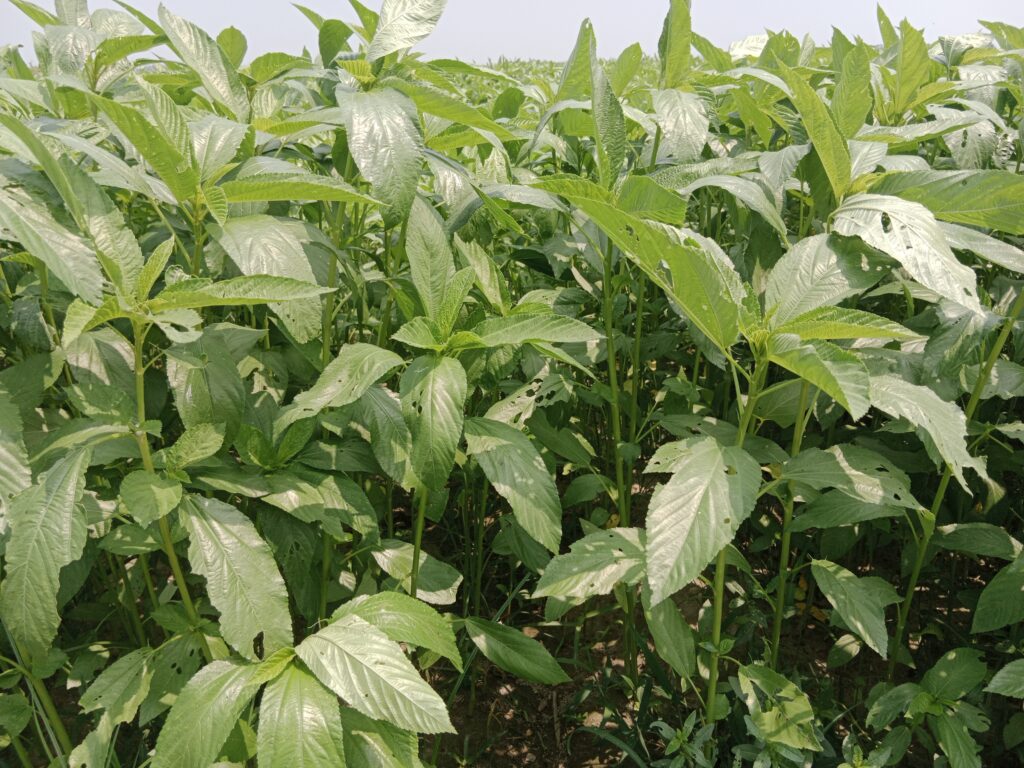
This profitability stems from moderate input requirements relative to fiber value, though it remains contingent on achieving optimal yields, effective pest/water management, and stable market prices.
Land Preparation
Land preparation for jute begins after harvesting the previous Rabi crop (like mustard, potato, or wheat), starting with deep initial plowing (20-25 cm) using a moldboard plow or tractor implement to bury weeds, stubble, and soil-borne pests/diseases while breaking hard pans.
The plowed clods are then sun-dried thoroughly for 1-2 weeks to kill pests, pathogens, and weed seeds. Following drying, 4-6 repeated cross-harrowings or plowings are performed at shorter intervals using disc harrows, cultivators, or local tools like the “country plow” to progressively break down the clods.
Subsequently, the field surface is leveled using a plank, leveler, or wooden beam after the final harrowing to ensure uniform water distribution (if irrigated) and facilitate sowing. The ultimate objective is to achieve a final tilth characterized by a loose, fine, crumbly soil texture without large clods, which is crucial due to the very small size of jute seeds.
Soil Type
Jute has specific soil requirements crucial for successful cultivation. The ideal soils are rich alluvial soils found in river basins and floodplains, offering excellent natural fertility and moisture retention. Loamy soils, characterized by a balanced mix of sand, silt, and clay, are also considered excellent as they provide optimal conditions for root development, aeration, water drainage, and nutrient availability. Suitable alternatives include sandy loams and clay loams, provided they possess adequate drainage and sufficient fertility levels.
Conversely, sub-optimal soils pose significant challenges: heavy clays suffer from poor drainage and are difficult to work, making them prone to waterlogging, which is detrimental to jute; pure sandy soils cannot retain adequate water and nutrients; and gravelly or stony soils physically impede root growth and hinder cultivation. Key soil requirements for jute are non-negotiable. Good drainage is essential, as jute plants are highly sensitive to waterlogging, especially during their vulnerable early seedling stage, and excess water can quickly kill the crop.
Fertility is paramount, requiring soils rich in organic matter to support the plant’s rapid vegetative growth and high nutrient demands. While jute exhibits tolerance to a relatively wide soil pH range (4.5 to 8.2), the optimum pH for maximizing yield and fiber quality lies between 6.0 and 7.5; soils falling below this acidic range often necessitate corrective liming.
Finally, soil texture, particularly the loamy types mentioned, is vital as it directly influences critical factors like root penetration depth, soil aeration, efficient moisture retention without saturation, and proper drainage – all fundamental for healthy jute development.
Climatic Requirements
With an ideal temperature range of 24°C to 37°C, jute grows best in a climate that is continuously warm and humid throughout the growing season. Sowing necessitates a minimum soil temperature of about 20°C, while temperatures below 15°C drastically impede growth and frost is fatal.
The crop needs a lot of moisture for germination and this critical growth period, preferring high humidity levels above 70%, because drought stress drastically reduces yield and fiber quality. This means that adequate and evenly distributed rainfall totaling between 1500 mm and 2500 mm is crucial, especially during the rapid vegetative growth phase. Furthermore, because lengthy daylight hours actively encourage its robust vegetative growth, jute needs complete exposure to the sun.
Major Cultivars
| Feature | Corchorus olitorius (Tossa Jute) | Corchorus capsularis (White Jute) |
| Common Name | Tossa Jute | White Jute |
| Fiber Quality | Higher quality, finer, stronger, silkier, more lustrous. Better for finer textiles. | Coarser fiber. |
| Stress Tolerance | Tolerant to water stress. More susceptible to waterlogging. | More tolerant of waterlogging and lower fertility. |
| Preferred Growing Areas | Well-drained areas. | Better suited to low-lying areas. |
| Major Cultivars | JRO 524 (Navin), JRO 7835, JRO 878, OM-1, O-9897, O-2010, BJRI Tossa Pat-5, BJRI Tossa Pat-6, KC-1 | JRC 321 (Sonali), JRC 4444 (Shyamli), JRC 212, D-154, BJRI Deshi Pat-7, BJRI Deshi Pat-8, CVL-1 |
Planting
a) Planting Season
The optimal sowing window for jute spans from February to May, strategically timed according to the anticipated onset of monsoon rains and prevailing local temperatures; specifically, Tossa Jute (Corchorus olitorius) is generally sown slightly earlier, typically during February to March, favoring well-drained areas, while White Jute (Corchorus capsularis) is sown a bit later, from March to May, particularly in regions prone to early waterlogging.
The fundamental goal of this carefully calibrated timing is to ensure seedlings become well-established before the arrival of heavy monsoon downpours and to enable the plants to complete their crucial vegetative growth phase during the peak of the rainy season.
b) Seed Rate
| Jute Species | Sowing Method | Seed Rate (kg/acre) | Row Spacing (cm) | Plant Spacing (cm) | Plants / m² |
| C. olitorius (Tossa) | Line Sowing | 2.0 | 25 | 5 | 80 |
| C. olitorius (Tossa) | Broadcasting | 3.0 | – | – | 80 |
| C. capsularis (White) | Line Sowing | 3.0 | 30 | 5 | 67 |
| C. capsularis (White) | Broadcasting | 4.0 | – | – | 67 |
c) Planting Method
Jute is planted using two primary methods: broadcasting and line sowing. Broadcasting, the most common traditional method, involves uniformly scattering seeds mixed with fine sand, ash, or soil over the prepared field; while simple, it requires a higher seed rate, results in less uniform plant distribution, and necessitates more thinning.
In contrast, line sowing (or drilling) is the preferred modern method, where seeds are precisely placed into continuous drills (shallow furrows) 2-3 cm deep using specialized tools like a seed drill, “pora,” or the corner of a plank; this approach ensures uniform spacing, significantly reduces seed requirements, and facilitates essential interculture practices such as weeding and fertilizing by maintaining clear rows.
d) Number of Plants per Acre
The number of jute plants per acre is 323,760.
Irrigation
Jute requires careful water management, being primarily rainfed in regions with adequate and well-distributed monsoon rainfall, but supplemental irrigation becomes essential during critical periods: specifically for germination, the early seedling stage (first 4-6 weeks), and any periods of drought stress during vegetative growth.
If a dry spell occurs immediately after sowing, irrigation is crucial to ensure seed germination and seedling establishment; it is also highly beneficial during prolonged dry spells in the vegetative phase, defined as receiving less than 50mm of rainfall per week. Supplemental water should be applied via light surface irrigation methods (such as controlled flooding or furrows) or sprinklers, always ensuring the field does not become waterlogged.
Paradoxically, effective drainage is equally vital and often more critical than irrigation for jute, as the crop is highly sensitive to waterlogging. Excess water from heavy rains must drain quickly from the field, as waterlogging for more than 2-3 days can be fatal, especially for Tossa jute. Proper land leveling and the construction of drainage channels are, therefore, fundamental practices to prevent water stagnation and protect the crop.
Fertilizer and Manure
| Nutrient | Crop | Rate (kg/acre) | Application | Purpose |
| Nitrogen (N) | C. capsularis (White) | 25–35 | Split: ½ basal, ¼ at 30–40 DAS, ¼ at 60 DAS. | Promotes vegetative growth & fiber yield. Use ammonium sulfate to reduce leaching. |
| C. olitorius (Tossa) | 15–25 | Same split as White Jute. | Same as above. Excess N degrades fiber quality. | |
| Phosphorus (P₂O₅) | All | 10–20 | Basal dose only, before or at sowing. | Prevents lodging, improves fiber quality & N-use efficiency. Balances excess N effects. |
| Potassium (K₂O) | All | 15–25 | Basal dose only, before or at sowing. | Reduces root/stem rot, supports plant health. |
| Sulfur (S) | All | 5–10 | Usually applied as basal dose. | Critical for fiber quality. |
Weed Control
| Aspect | Details | |
| Critical Period | First 30–45 days after sowing (until canopy closure). | |
| Methods | ||
| Mechanical/Cultural | Hand Weeding: 2–3 weedings: 1st at 15–20 DAS, 2nd at 30–35 DAS, 3rd if needed around 45 DAS; thinning done with 1st weeding. Hoeing: Use of hand hoes or wheel hoes between rows. | |
| Chemical (Herbicides) | Pre-emergence: Pendimethalin (1.0–1.5 kg a.i./ha) or Fluchloralin (0.75–1.0 kg a.i./ha) applied after sowing. Post-emergence: Quizalofop-ethyl (50–75 g a.i./ha) for grassy weeds at 4–6 leaf stage. | |
| Importance | Weeds compete fiercely for light, water, and nutrients during the establishment phase, reducing yield. | |
Pest and Disease Management
Common Pests
a). Jute Semilooper
Mostly in its larval form, the Jute Semilooper (Anomis sabulifera) is a severely destructive insect that affects jute crops. The larvae’s voracious feeding on jute leaves causes widespread defoliation, which impairs the plant’s ability to photosynthesize. In addition to weakening the plants, this damage causes notable decreases in fiber yield and quality, which eventually affects the crop’s total productivity and economic worth. To lessen the losses brought on by this pest, effective pest management techniques are crucial.
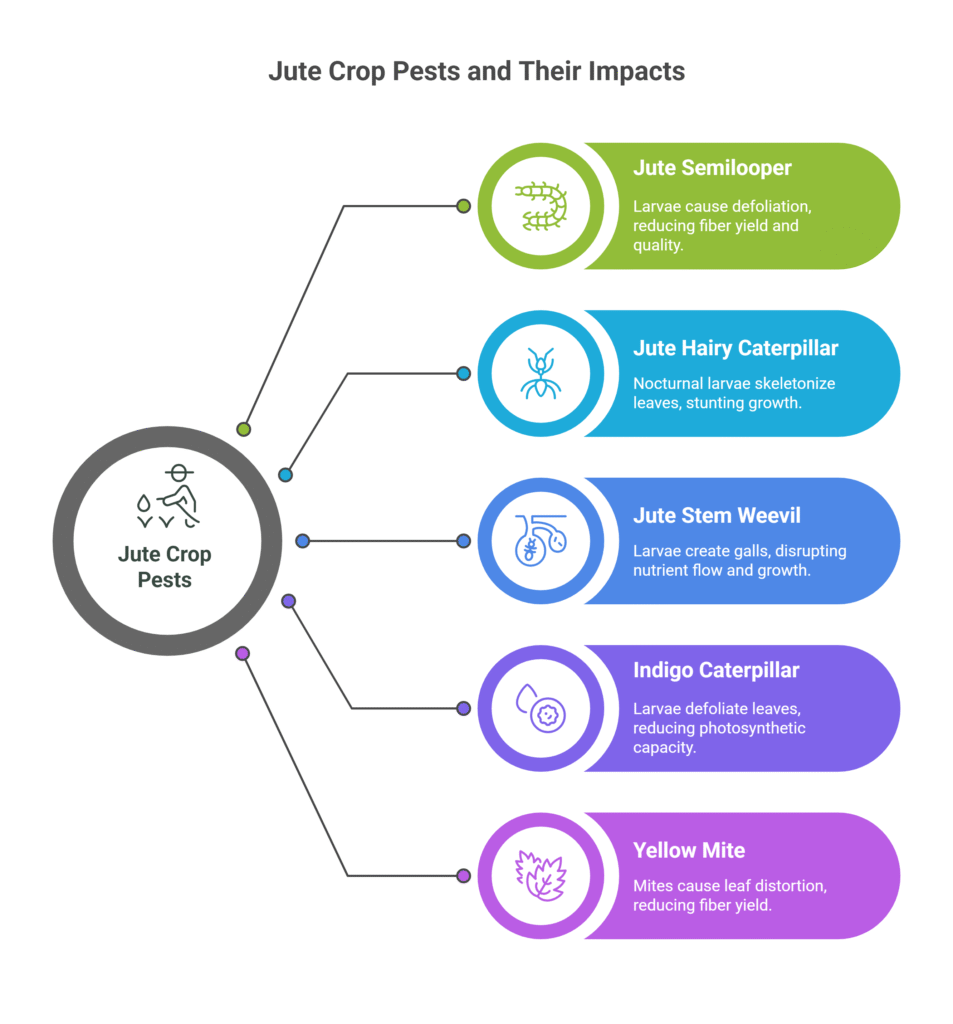
b). Jute Hairy Caterpillar
The Jute Semilooper (Anomis sabulifera) stands as one of the most devastating insect pests in jute cultivation, primarily due to the destructive feeding behavior of its larval stage; these voracious green caterpillars, often active nocturnally, consume large sections of jute leaves, leading to extensive skeletonization and severe defoliation, which drastically reduces the plant’s photosynthetic capacity, weakens overall vigor, stunts growth, and ultimately causes significant losses in both fiber yield and quality, making timely identification and management critical to prevent economic damage to the crop.
c). Jute Stem Weevil
The jute stem weevil (Apion corchori) inflicts significant damage during its larval stage, as the young grubs bore into the tender stems and shoots of jute plants, creating characteristic swollen formations known as galls; these galls disrupt the vascular system, impeding the critical flow of water and nutrients, which severely weakens the plant’s structural integrity, stunts overall growth, reduces fiber quality and yield, increases susceptibility to lodging (stem breakage), and ultimately diminishes crop productivity through both direct physical damage and physiological stress.
d) Indigo Caterpillar
The Indigo Caterpillar (Spodoptera exigua), also known as the Beet Armyworm, is a highly destructive polyphagous pest whose larval stage poses a significant threat to young jute plants; these voracious, greenish to brown larvae feed nocturnally, chewing irregular holes in leaves, causing extensive defoliation, and often skeletonizing foliage, which severely reduces the plant’s photosynthetic capacity, stunts growth, weakens stems, and ultimately leads to substantial yield and fiber quality losses, especially during the vulnerable early growth stages before canopy closure, with outbreaks capable of rapidly defoliating entire fields if left uncontrolled.
e). Yellow Mite
The Yellow Mite (Polyphagotarsonemus latus), also known as the Broad Mite or Tropical Mite, is a minuscule but highly damaging pest of jute, infesting the tender growing points, young leaves, and buds; its feeding activity injects toxic saliva that causes severe physiological distortions, including downward curling and crinkling of leaves, a characteristic leathery texture, and a distinct yellow or bronze discoloration (bronzing), which drastically reduces photosynthetic efficiency, stunts plant growth, suppresses shoot development, and ultimately leads to significant losses in fiber yield and quality, with infestations often going unnoticed until severe symptoms manifest due to the pest’s microscopic size and rapid reproduction in warm, humid conditions.
Common Diseases
a). Stem Rot
Stem rot is a severe disease in jute crops, characterized by wilting and the blackening of stems, which can lead to significant losses in plant vigor and yield. The disease thrives under conditions of waterlogging or drought stress, as both extremes create an environment conducive to the pathogen’s proliferation.
Waterlogging reduces oxygen availability in the soil, weakening plant defenses, while drought stress compromises the plant’s ability to maintain healthy tissues. Effective management practices, such as ensuring proper drainage, avoiding prolonged water stress, and using resistant varieties, are critical to minimizing the impact of stem rot on jute production.
b). Anthracnose
A fungal disease called anthracnose, which causes leaf spots and stem lesions, has a major effect on jute harvests. Usually round, black, and tiny, the leaf spots frequently grow and combine to create asymmetrical patches that lower the plant’s photosynthetic efficiency. Long, sunken areas that weaken stems and can cause lodging under severe infections are known as stem lesions.
Due to its detrimental effects on plant growth and fiber quality, this disease can result in significant yield losses. Warm temperatures, thick crop canopies, and high humidity are all conducive to its spread. Effective anthracnose control requires integrated disease management techniques, such as crop rotation, the use of resistant cultivars, appropriate spacing, and prompt fungicide administration.
c) Black Band
A fungal disease known as “Black Band” affects jute crops and is typified by the development of noticeable black streaks on the stems, especially close to the base of the plant. Because of the pathogen’s invasion, these streaks damage the stem structure, which may result in less robust and stable plants.
High humidity and unsanitary field conditions are frequently linked to the disease, which makes it easier for the fungus to grow and spread. Black Band can have a major effect on fiber yield and quality if it is not controlled. Applying the right fungicides as preventive or curative treatments, keeping the field clean, and making sure there is enough space between plants to lower humidity around them are all examples of effective control strategies.
d) Soft Rot (Sclerotium rolfsii)
White mold at the base of the stem is a sign of soft rot, a dangerous disease that affects jute crops and is brought on by the fungus Sclerotium rolfsii. This mold is a warning that a fungal infection is developing, which weakens the stem tissue and frequently causes plant collapse and large output losses.
The fungus multiplies quickly in warm, humid environments and poorly drained soils, which are ideal for the disease. Enhancing soil drainage, preserving field cleanliness, preventing plant damage during cultivation, and using fungicides or bio-control agents to inhibit fungus growth are all components of effective management.
e) Root Knot Nematode (Meloidogyne spp.)
Microscopic parasitic worms known as root knot nematodes (Meloidogyne spp.) infect the roots of jute crops and produce distinctive knots or galls, which seriously harm the crops. These galls interfere with the root system’s regular operation, affecting the intake of nutrients and water, which causes plants to develop more slowly, have their leaves turn yellow, and have less vitality.
Plants with infestations are frequently more vulnerable to environmental stressors and subsequent diseases. Warm, moist soil is ideal for the worms’ growth, and populations can increase throughout multiple cropping seasons, especially in fields with inadequate crop rotation.
The use of resistant jute types, soil solarization, crop rotation with non-host plants, and the application of nematicides or biological control agents to lower nematode numbers and lessen crop losses are all examples of effective management techniques.
Harvesting
| Aspect | Details |
| Timing Importance | Critical for fiber quality and yield; too early → low yield, too late → coarse, brittle fiber. |
| Optimal Stage | Early pod stage for both species: – C. capsularis: Small pods appear (100–110 DAS) – C. olitorius: First pods formed (120–150 DAS) |
| Indicators | Plants shed leaves – Pods change from green to brownish (early stage) – Lower leaves turn yellow and drop – Stem color changes from green to yellowish/reddish |
| Harvest Method | Cutting: Use a sharp sickle or jute harvester and cut close to the ground. Bundling: Gather stems into bundles approximately. 20–25 cm diameter |
Yield
Jute cultivation typically yields 18 to 20 tonnes of green plant weight per acre, with fiber yield ranging from 0.8 to 1 tonne per acre, depending on cultivation practices and environmental conditions.
Post Harvest
Retting
Retting is a crucial post-harvest process in jute cultivation, used to separate the fibers from the woody stalk. This involves submerging bundles of jute stems in clean, slow-flowing water such as rivers, canals, ponds, or tanks for 10–20 days. During this period, microbial activity breaks down the pectins that bind the fibers to the stalks, facilitating their separation. The process is considered complete when the fibers can be easily separated from the stalks by hand rubbing. Proper retting is essential to ensure high-quality fibers and optimal yield.
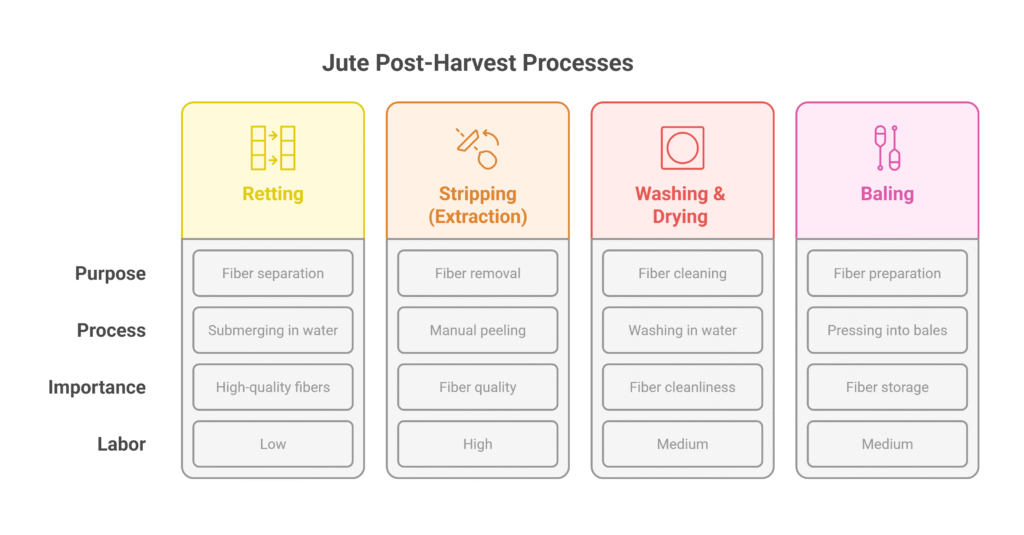
Stripping (Extraction)
Stripping, or fiber extraction, is the manual process carried out after retting to remove jute fibers from the stalk. This involves breaking the woody core, commonly referred to as the stick, and carefully peeling off the fibers. Skilled labor is required to ensure the fibers are stripped cleanly and uniformly, preserving their quality for further processing. Proper stripping is crucial, as it determines the smoothness, strength, and overall grade of the fiber. This step, although labor-intensive, is essential for preparing jute for subsequent stages of processing and market readiness.
Washing & Drying
Washing and drying are critical steps in preparing jute fibers after stripping to ensure their cleanliness and quality. The extracted fibers are thoroughly washed in clean water to remove residual mucilage, dirt, and any microbial debris accumulated during retting. Proper washing enhances the luster and texture of the fibers, making them suitable for commercial use. After washing, the fibers are carefully hung on bamboo poles or spread out on clean ground to dry completely, typically over 2–3 days. Adequate drying is essential to prevent fungal growth, ensure proper storage, and maintain the strength and durability of the fibers for further processing or sale.
Baling
Baling is the final step in jute fiber processing, where dry and clean fibers are carefully graded according to key quality parameters such as color, strength, fineness, and luster. This grading ensures that fibers of similar quality are grouped, facilitating better market valuation and efficient handling. Once graded, the fibers are compactly pressed into bales, which not only makes them easier to store and transport but also helps protect the fibers from contamination and damage. Proper baling is essential for maintaining fiber quality during storage and marketing, ultimately influencing the price and demand in the commercial jute industry.
Cost of Investment per Acre (Local Variety Jute Farming)
| S.N. | Category | Cost (NRs.) |
| 1 | Land Preparation (Plowing) | 5,000 |
| 2 | Seed Rate | 1,000 |
| 3 | Labor (Seed Sowing) | 1,000 |
| 4 | Fertilizers and Manure | 2,000 |
| 5 | Irrigation | 2,000 |
| 6 | Weed Control | 1,000 |
| 7 | Pest & Disease Control | 2,000 |
| 8 | Harvesting | 2,000 |
| 9 | Post-Harvest Activities | 4,000 |
| 10 | Miscellaneous Costs | 3,000 |
| Total Investment Cost | 23,000 |
Income from 1 Acre Jute Farming
| Particulars | Yield (kg/acre) | Market Price (NRs/kg) | Total Income (NRs.) |
| Jute Fiber Yield | 1,000 | 100 | 100,000 |
Analysis of Jute Farming Profit Per Acre
| Metric | Calculation | Amount (NRs.) |
| Gross Income | Fiber Yield × Price | 100,000 |
| Total Cost | Sum of all investments | 23,000 |
| Net Profit | Income – Cost | 77,000 |
| Profit Margin | (Profit ÷ Income) × 100 | 77% |
| ROI | (Profit ÷ Cost) × 100 | 335% |

